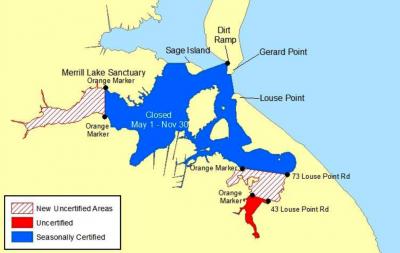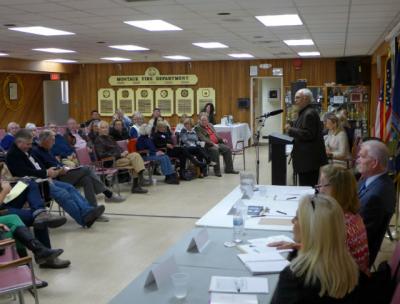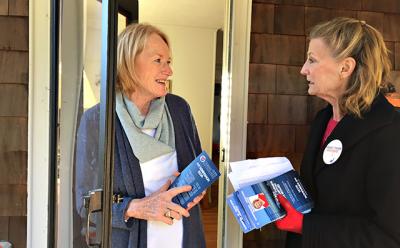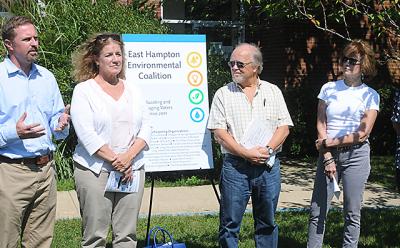Energy Plan Is Presented
Energy Plan Is Presented
Members of East Hampton Town’s energy sustainability advisory committee presented a draft climate action plan to the town board on Tuesday, urging its swift adoption and implementation to adapt to and mitigate the effects of climate change.
John Botos, an environmental technician with the town’s Natural Resources Department, and Gordian Raacke, executive director of the advocacy group Renewable Energy Long Island, recommended actions including retrofits of facilities, replacement or conversion of vehicles, energy-efficiency upgrades and stormwater management on residential properties, and long-range planning for coastal resiliency.
The climate action plan, Mr. Botos said, results from the town board’s 2009 and 2010 resolutions to join the state’s Climate Smart Communities program and builds on the town’s comprehensive management plan, local waterfront revitalization plan, clean energy action plan, and comprehensive energy vision.
It dovetails, Mr. Raacke said, with New York State’s “ambitious goal to reduce greenhouse gas emissions, the gases that cause climate change,” 80 percent below current levels by midcentury.
The plan, he said, uses as a benchmark the New York Institute of Technology’s local greenhouse gas emission inventory for East Hampton — in 2010, an annual rate of 350,000 metric tons. “The good news is, by knowing where we’re starting we can measure our progress, and we will be,” Mr. Raacke said. The plan also gives the town, for the first time, greenhouse gas inventories of its facilities and fleet, which will also aid in assessing progress toward goals and emissions and cost savings.
Potential initiatives to reduce municipal facilities’ carbon footprint, Mr. Botos said, should include retrofits adding solar installations and wind turbines, as well as improved lighting, insulation, and window replacements. The plan also calls on the town government to explore partnerships with the state’s Boards of Cooperative Educational Services to encourage energy efficiency in school districts, and to implement a web-based interface of automation systems to monitor and control town-owned buildings. These actions would reduce emissions while saving money, he said. “It does pay to go green.”
Mr. Botos referred to the Town of Southold’s Human Services Department, which he said has saved $100,000 in fuel costs by changing the vehicles used for its home-delivered meals program for senior citizens. While East Hampton Town has already installed an electric vehicle charging station at Town Hall, the plan also calls for the town’s fleet to be replaced or converted with a focus on electric and hybrid vehicles, while locations for additional charging stations should be identified. Vehicle sharing between departments and among school districts would further reduce emissions.
In the residential sector, “one thing we really need to do is make sure every new home to be built here is top-notch energy efficient,” Mr. Raacke said. “If we don’t, we’re building a home that has a huge hole in the wall,” needlessly wasting homeowners’ money “and emitting much more greenhouse gases than we have to.” He suggested a new building code that would require new and reconstructed houses to be subject to a home energy rating system as administered by the Residential Energy Services Network, a nonprofit that produces energy efficiency standards. Houses meeting this standard, he said, would be 40 to 50-percent more energy efficient than a conventional house. Another recommendation was to require new residential construction to incorporate stormwater management features.
Planning for the effects of climate change, including sea level rise, should be integrated into other town initiatives, according to the plan. The town has already applied for and received a $250,000 grant to compile a coastal assessment resiliency plan, which would guide development of a long-range strategy for addressing coastal concerns such as erosion, sea level rise, and flooding.
The draft climate action plan is “a mechanism for starting a discussion,” Mr. Botos said. “This will start the process of engaging the community.” All boards and departments, he said, should collaborate and educate one another to identify strengths and vulnerabilities.
“We’re not alone,” Mr. Raacke told the board, referring to 167 other municipal participants in the Climate Smart Communities program. “There is other intelligent life out there.” The Towns of Southampton and Huntington, he said, are in the process of drafting climate action plans.
The plan, Supervisor Larry Cantwell said, presented “a lot for us to digest,” but “we’re anxious to move forward” to meet the town’s energy-efficiency goals. Implementing a final plan, he said, “is going to require day-to-day work and some training and communication of staff and employees about how they can help us get there.” The board, he said, will rely on the energy sustainability committee to assist in the plan’s implementation.




